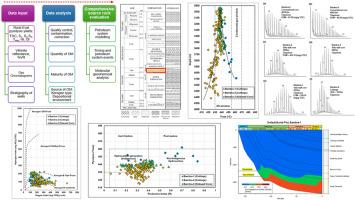澳大利亚Barrow亚盆地Dingo粘土岩烃源岩特征——污染对地球化学分析的影响
IF 3.6
引用次数: 0
摘要
对澳大利亚Barrow亚盆地Dingo粘土岩进行了烃源岩特征和生烃潜力建模综合研究。在本研究中,数据仅来自Bambra-1和Bambra-2井。收集的数据包括对晚侏罗世Dingo粘土岩岩屑和侧壁岩心的大量地球化学分析。结合岩石热解、萃取有机质气相色谱(GC)等地球化学数据,对丁戈泥岩进行烃源岩表征,并构建其埋藏史和生烃史。为了提高热成熟度估算的准确性,只考虑S2大于1的样品,因为在S2值较低的样品中可能存在峰积分和Tmax测定的不确定性问题。此外,由于岩屑和侧壁岩心(SWC)样品受到钻井泥浆添加剂和天然烃的污染,Bambra井的Rock-Eval数据可能不可靠,这可能会影响确定热成熟度数据的可靠性。研究表明,Dingo组总有机碳(TOC)含量在0.66% ~ 8.31%之间。产油率(PY=S1 + S2)为1.37 ~ 10.44 mg HC/g。氢指数值在42 ~ 226 mg HC/g TOC之间变化,表明Dingo粘土岩以干酪根III型为主,II/III型和IV型贡献较小,热成熟度从未成熟到晚成熟,主要处于油窗。Tmax值为398 ~ 462℃,镜质组反射率(Ro, %)为0.47 ~ 1.99。一些样品的Tmax被抑制,产量指数更高,这是钻井作业中受钻井液影响的样品的典型特征。此外,气相色谱(GC)分析解释了古沉积环境,显示了海相和陆相烃源岩的混合输入。对Bambra-1和Bambra-2井进行了一维盆地建模,以评估该地层的埋藏和热史。转化比表明油气生成尚未达到峰值,仍处于持续阶段。根据转化比,可以在该地层中发现油气运移的迹象。污染的影响需要进一步调查,因为它可能会显著影响成熟度估计和数据可靠性。本文章由计算机程序翻译,如有差异,请以英文原文为准。

Source rock characterization of the Dingo Claystone, Barrow Sub-basin, Australia – Influence of contamination on geochemical analyses
An integrated study on source rock characterization and hydrocarbon generation potential modeling was conducted for the selected Dingo Claystone, Barrow Sub-basin, Australia. In this study, data were collected solely from two wells represented by the Bambra-1 and Bambra-2 wells. The collected data include those from bulk geochemical analyses of cuttings and sidewall cores sampled from the Late Jurassic Dingo Claystone. Geochemical data obtained from Rock-Eval pyrolysis and gas chromatography (GC) of extracted organic matter were integrated for source rock characterization and the construction of burial history and hydrocarbon generation in the Dingo Claystone. To improve the accuracy of thermal maturity estimations, only samples with S2 greater than 1 were considered due to potential issues with peak integration and uncertainties of Tmax determination in samples with lower S2 values. Furthermore, Rock-Eval data from the Bambra wells may be unreliable due to the contamination of cuttings and side-wall core (SWC) samples by drilling mud additives and natural hydrocarbons, which could impact the reliability of the data for determining thermal maturity. This study reveals that the Dingo Claystone Formation has total organic carbon (TOC) contents ranging from 0.66 % to 8.31 %. A poor to good hydrocarbon generation potential is indicated, with a production yield (PY=S1 + S2) ranging from 1.37 to 10.44 mg HC/g rock. Hydrogen index values vary between 42 and 226 mg HC/g TOC, confirming that the Dingo Claystone is dominantly kerogen Type III, with minor contributions from types II/III and IV. Thermal maturity ranges from immature to late mature and is mostly in the oil window. This is indicated by Tmax values of 398–462 °C and vitrinite reflectance (Ro, %) of 0.47–1.99. Some samples show suppressed Tmax and a higher production index, which is typical for samples affected by drilling fluids during drilling operations. Additionally, gas chromatography (GC) analyses are used to interpret the paleodepositional environment showing mixed input between marine and terrestrial origins of the source rocks. One-dimensional basin modeling for the Bambra-1 and Bambra-2 wells was carried out to evaluate the burial and thermal history of the formation. The transformation ratio suggests that hydrocarbon generation has not reached its peak and is still in an ongoing phase. An indication of hydrocarbon migration can be observed in this formation based on the transformation ratio. The effects of contamination warrant further investigation, as it could significantly impact maturity estimates and data reliability.
求助全文
通过发布文献求助,成功后即可免费获取论文全文。
去求助

 求助内容:
求助内容: 应助结果提醒方式:
应助结果提醒方式:


